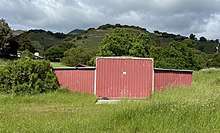Carmel Valley Airport
Carmel Valley Airport was a privately-owned Airpark in Carmel Valley, California from 1941-2002.[1] The airport was later called the Carmel Valley Vintage Airfield. The California Historical Resources Commission voted to nominate the "Carmel Valley Vintage Airpark" (CVVA) as a State Historic Resource. The Commission found that development of the airport was important as it represented the "first airpark in the United States and in the world."[2]
Carmel Valley Airport | |
|---|---|
 Carmel Valley Airport | |
| Summary | |
| Airport type | Private |
| Location | Carmel Valley, California |
| Opened | 1941 |
| Closed | 2002 |
| Time zone | PST (-6:00) |
| • Summer (DST) | PDT (-7:00) |
| Coordinates | 36°29′10″N 121°43′26″W |
History
In the 1930's, the property was used for growing oats by bush pilots before the airport development. In 1940, Byington Ford and his brother, Tirey L. Ford Jr., developed the Airport for pilot owners who wanted to be “at home a minute or two after getting out of their planes.” Two hangar houses were built at the airport as well as a prototype hangar-house to serve as an example for the "airborne community of the future."[3]
The grand opening of the airport was on December 7, 1941. However, on the same day, Japan attacked Pearl Harbor. All private planes were banned from flying on the west coast. As a result, the airport project was put on hold while Ford joined the Army Air Corps to aid in the US war effort.[3] Following the World War II Ford revived his dream of a residential airpark.[3]


Non pilots bought up many of the Airpark homesites. To suit their tastes Ford created ranch style house sites of 1-3 acres. He envisioned hillside homes where residents could view incoming planes. Dean Wolter ran a flying club at the airfield with a few members.[3]
During World War II, the airfield served as an alternative landing field for the military planes flying out of Watsonville and King city.[3]
In 1949, the State of California licensed the airport. Ford built a residence near the Carmel Valley Village, where he lived for some time. In 1952, Lou Gardner purchased Ford’s residence and after building motel rooms around the residence, opened the Blue Sky Lodge in 1953. The lodge is still in operation today. In 1953, Ford retired and Peter Delfino purchased the property for $35,000. Delfino developed the airpark runway and hosted several aviation events. He continued this endeavor into the 1980s.[3]
On November 3, 2000, The California Historical Resources Commission voted to nominate Carmel Valley Vintage Airpark as a State Historic Resource. The Commission found that development of CVVA by Ford in 1941 was "significant" because it represented the first airpark in the United States and in the world. On July 3, 2001, an article appeared in the Los Angeles Times that said: “The nation’s first airpark was built in Carmel Valley. It was started by By Ford, a man with a vision that planes would someday be as popular as cars for everyday transportation.”[4]
The vintage airfield was used by the helicopters fighting the 2016 Soberanes Fire.[5]
Shutdown of airport
The Monterey County Board of Supervisors was intent on shutting down the airport. A handful of Carmel Valley residents aligned themselves toward the same goal. A group of local pilots and residents formed the "Carmel Valley Historic Airpark Society" (CVHAS) in 2000. They set out to fight the closure.[3]
In May 2002, after 53 years of operating the airport, the Delfino family made a decision to close the airport for commercial use.[6]
Santa's Fly-in
The airfield is the site of an annual mid-December Santa's Fly-in event. Santa Claus and Mrs. Claus arrive by helicopter and then lead a parade to the nearby Carmel Valley Youth Center for photos, food and drink, and crafts. The event started in 1959 and December 2019 was the event's 61st year.[7][8]
Carmel Valley airport as open space
On September 15, 1953, a committee was organized to form a corporation, named the "Carmel Valley Airpark," to preserve the airport.[9] That effort has continued through the years and on June 15, 2018, a group of concerned residents came together to save the airfield from development.[10] The community group has become a registered California Nonprofit organization and has received federal IRS tax-exempt status.[11]
References
- "Monterey Peninsula Briefs". www.newspapers.com. Salinas, California. 1941-03-18. Retrieved 2020-04-21.
- Carol, Brenda (2000-12-06). "Carmel Valley Vintage Airpark Threatened with Closure: Local Pilots and Concerned Citizens Fight Back". www.avweb.com. Retrieved 2020-04-23.
- Allaire, Lou (2014). "Carmel Valley Vintage Airfield 1941-2002" (PDF). carmelvalleyhistoricalsociety.org. Carmel Valley Historical Society. Retrieved 2020-04-22.
- Carpenter, Susan; Willman, Martha L. (2001-07-03). "Living at Runway's Edge". Los Angeles Times. California. Retrieved 2020-04-23.
- "Helicopters provide key support to crews fighting Soberanes Fire". Monterey Herald. 2016-07-28. Retrieved 2020-07-16.
- Marino, Pam (July 5, 2018). "Carmel Valley residents band together to purchase vintage airfield as parkland". Monterey County Weekly. Retrieved 2020-02-28.
- "Santa's Fly-in at the Carmel Valley Community Youth Center". Monterey County Weekly. Retrieved 2020-07-26.
- "Santa Fly-In: Old St. Nick, Mrs. Claus bring Christmas greetings to Carmel Valley". Monterey Herald. 2015-12-12. Retrieved 2020-07-26.
- "Carmel Valley Group Has Plan to Save Airport". www.newspapers.com. The Californian. 1953-09-15. Retrieved 2020-04-22.
- Counts, Chris (June 15, 2018). "C. V. airport site should be open space, group says" (PDF). pineconearchive.fileburstcdn.com. Carmel Pine Cone. Retrieved 2020-04-22.
- Hertlein, Joe (March 2019). "Carmel Valley Save Open Space" (PDF). www.carmelvalleyassociation.org. Carmel Valley Perspectives. Retrieved 2020-04-22.
Go to CVSOS.org to learn more.
External links
- Carmel Valley Historical Society (official site)